|
Wisley's Alpine Log
By Paul Cumbleton
Log 9 22nd Nov 2007
Daubenya
My last log looked at Massonia as the first of a two-parter which now concludes with the genus Daubenya, including a look at the cultivation of the two genera. Even if you think these are not your thing, do read to the end of the plant descriptions- I've kept the best, most spectacular plant till last!
Daubenya now has eight recognised species: D. alba, D. aurea, D. capensis, D. comata, D. marginata, D. namaquensis, D. stylosa, and D. zeyheri. Of these, D. marginata is probably the widest grown, still often found under its old name of name of Neobakeria angustifolia. Some of the species are still rare in cultivation, at least in the UK, but all are highly worth growing and often with much more colourful flowers than the Massonias discussed last time.
Daubenya alba : This is a recently discovered species first described in 2002 and coming from the edge of the Roggeveld escarpment in the Northern Cape Province. The name suggests white flowers, but they may also commonly be pale lilac. They are easily distinguished from other Daubenyas by the long tubes formed by the united stamens.
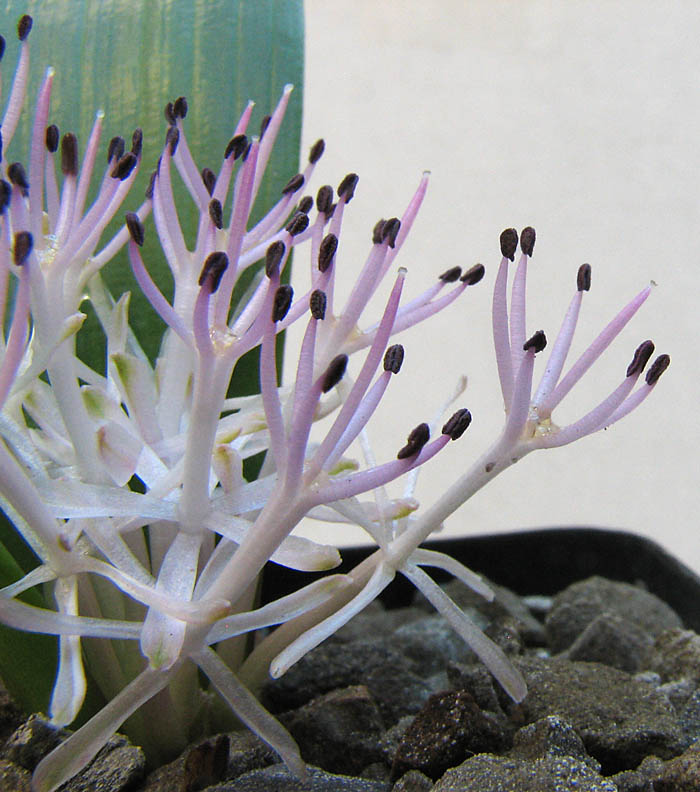
Daubenya alba
Daubenya aurea : From the western Karoo (only) comes this amazing species with its extraordinary flowers, instantly recognisable due to each of the outer flowers having one of its petals enlarged. It is thought that this arrangement gives the inflorescence the overall appearance of being the ray florets of a daisy - and this attracts the monkey beetles that pollinate them. This is a different pollination strategy to many of the other species, most of which are generalists pollinated by bees and butterflies. The flowers are either bright red or bright yellow, the two colours occurring in separate colonies. I have yet to flower this species - it seems slower from sowing to flower than many other South African bulbs. So I don't have a picture of my own to show you - but I am grateful to Audrey Cain for letting me use this stunning shot of a mass flowering of the red form in the wild:
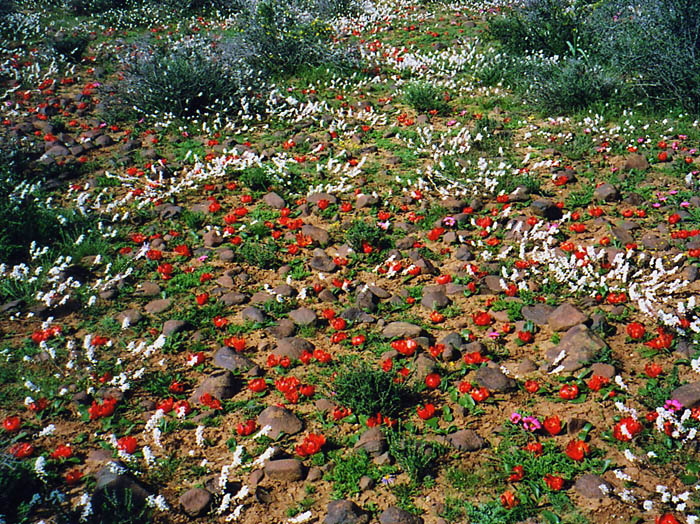
Daubenya aurea in the wild by Audrey Cain
There are some other good pictures of this species on the excellent website of The Pacific Bulb Society, at http://www.pacificbulbsociety.org/pbswiki/index.php/Daubenya
Daubenya capensis : I have yet to see this species which is rare in cultivation in the UK, though I have this year sown some seed, a few of which have just germinated (though not exactly prolifically!). So I am sorry but I have no picture to show you, though there is one in the book "The Colour Encyclopedia of Cape Bulbs" and the odd one on the web such as at http://216.247.182.213/ABOUT_IBS/Publications/HERBERTIA/vol56/Daubenya.html
The species has a restricted distribution (like many of the Daubenyas), occurring only on the Bokkeveld escarpment near Nieuwoudtville. The flowers are yellow.
Daubenya comata : Another species that is rare in cultivation, even though in the wild it has a wider distribution than most other Daubenyas, occurring in the Free State, Northern Cape and the North Eastern parts of Western Cape. This puts it into areas that get some summer rainfall, but it still behaves as a winter grower. Grazing threatens this species survival in some of its range. The flowers can be white or pinkish and have a strong spicy scent. This is one of the pinkish ones:
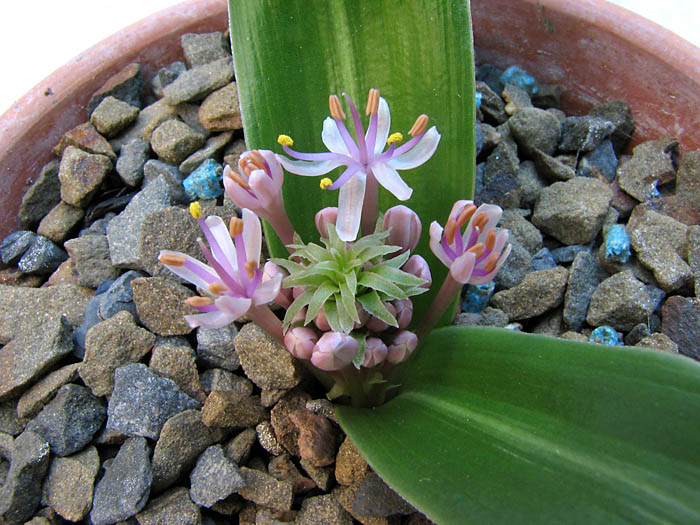
Daubenya comata
Daubenya marginata : Seen more commonly in cultivation, this plant comes from the Roggeveld and the North Western Cape. In some of its range it grows alongside D. aurea and seed collections of one species may be contaminated with seed of the other. The flowers are yellow, with the prominent filaments a more orangey-yellow and make a fine display, often in December with me, so a Christmas treat. We have this species planted out in the Landscaped House at Wisley, along with Massonia pustulata, M. pygmaea and M. depressa in a section devoted to the South African flora. Here is one of the potted specimens:
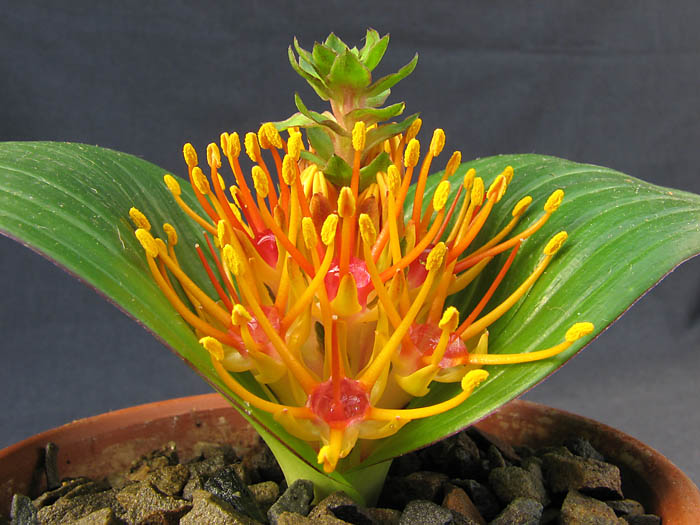
Daubenya marginata
Daubenya namaquensis : Another rare species, very restricted in the wild to one small area near Bushmanland. This is another one I have not flowered yet and can't show you a picture, though a few seedlings have germinated for the first time this year. It is supposed to make a rather robust plant with ribbed leaves and a large flower inflorescence with dark yellow flowers. There is a picture in the same web article at the address given above under D. capensis.
Daubenya stylosa : A most attractive species with glowing bright yellow flowers that have a smell of honey. For me this starts flowering in October and goes on into November
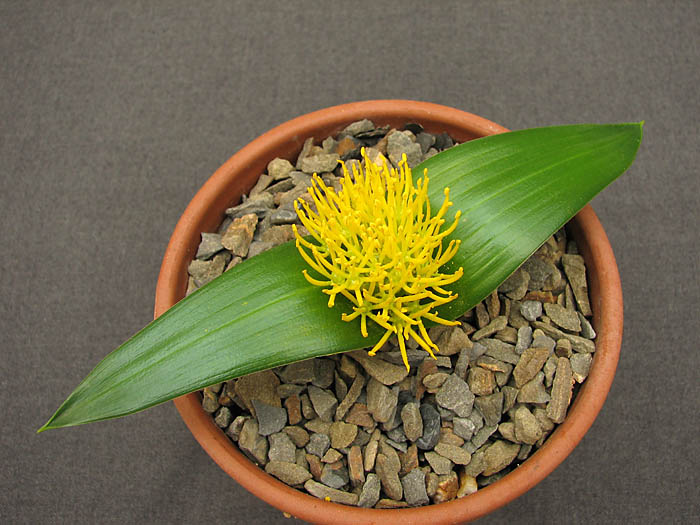
Daubenya stylosa

Daubenya stylosa closer view of flower
Daubenya zeyheri : I said I had kept the best till last and this is it, in my view anyway. From calcareous-coastal sands in the South Western Cape, it has glossy green leaves and flowers with white petals and showy red-orange filaments. That much alone makes this an attractive plant when viewed side on like this:
.jpg)
Daubenya zeyheri (side view)
But the wonderful surprise comes when you view it from above. The bottoms of the stamens are coloured purple and this colour reflects in the copious nectar pools that gather in the flowers. It looks like the flowers are filled with glowing amethysts…this plant can truly be described as a jewel of the desert!! Enjoy…
.jpg)
Daubenya zeyheri (from above)
Cultivation of Massonia and Daubenya
Both Massonia and Daubenya are treated like most of our other winter-growing South African bulbs at Wisley. We keep them in a just frost-free glasshouse, but many may be OK under cold glass with fleece protection during cold periods. Potting can be done anytime during their summer dormant period; we usually do it in August. Our compost mix is: Equal parts (by volume) of John Innes no. 3, peat, perlite and coarse grit. The peat fraction is added to ensure the compost is on the acid side of neutral, which the majority of the winter-growers prefer. Unlike many other bulbs, I find Massonias and Daubenyas do not like to be too deep in the pot, so I start by planting them with their noses just a couple of cm deep. Then, as Ian has often advised in his bulb log, you can be guided in future years by how deep they have adjusted themselves to be.
Watering commences at the beginning of September with an initial drench and subsequent waterings guided in the usual way by the amount of growth and the dampness of the compost. They seem to like plenty of water while in growth and certainly should NOT be allowed to dry out at any point while growing. Rainwater is best to avoid any possibility of adding lime from hard water. I fertilise them approximately once a month with a liquid feed of a phosphate-free formulation (NPK of 1-0-2), as most South African bulbs from the winter rainfall area grow in soils with very low phosphate levels and will not tolerate high levels. Once the leaves show signs of yellowing in Spring (often around March) I stop watering and then leave them completely dry for their summer dormancy. As with all the winter-growers, I give them as much sunlight as possible in winter but don't go as far as giving them extra light artificially. They seem largely free of serious pest or disease problems, with one exception - the faded flowers are V
ERY prone to Botrytis and must be removed as soon as they have faded.
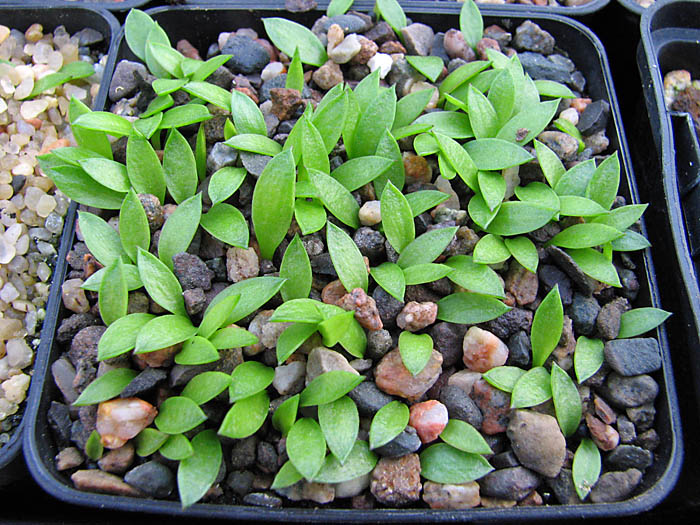
Massonia pustulata seedlings 8 weeks after sowing
Massonia & Daubenya bulbs rarely split or produce offsets, so propagation from seed is the best way. Fortunately, seed usually germinates freely, as in the picture above. Seed should be stored warm, not in a fridge, through the summer as it requires a period of "after-ripening" at warm temperatures. Sow it at the beginning of September, using the same mix as for the adult bulbs and put outside in a shady place until germination (usually within 6 weeks). They like cool nights of 10C or below followed by warmer day temperatures up to 20C to give them a wide diurnal range of temperatures which stimulates germination. Once germinated, bring inside to a just-frost-free greenhouse and give more light. Grow on just like the adult bulbs. They can be tipped out and potted separately during their dormancy after their first or second year. Many will attempt a first flower in their third season of growth.
^ back to the top ^
|

